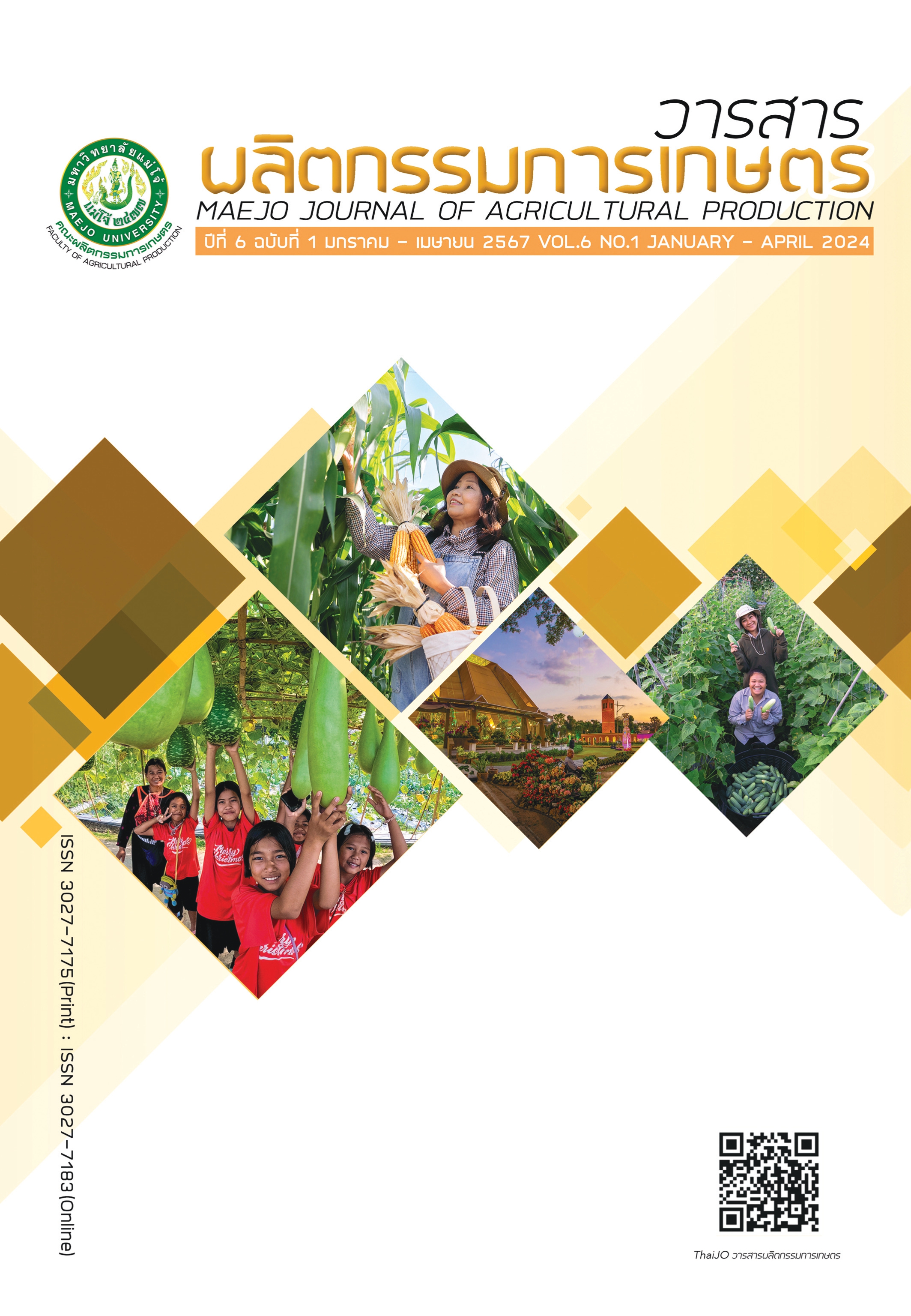ผลของระยะเวลาเก็บเกี่ยวและสภาพการเก็บรักษาที่มีต่อคุณภาพเมล็ดพันธุ์ข้าวโพดเลี้ยงสัตว์ลูกผสมเดี่ยว
Main Article Content
บทคัดย่อ
การศึกษาผลของระยะเวลาเก็บเกี่ยวที่มีต่อผลผลิตและคุณภาพเมล็ดพันธุ์ข้าวโพดเลี้ยงสัตว์ลูกผสมพันธุ์สุวรรณ 5819 วางแผนการทดลองแบบ split-split plot in completely randomized design จำนวน 4 ซ้ำ ปัจจัยหลัก คือ 2 สภาพการเก็บรักษาที่ 15 องศาเซลเซียส ความชื้นสัมพัทธ์ 45 เปอร์เซ็นต์ และอุณหภูมิห้อง ปัจจัยรอง คือ ระยะเวลาเก็บเกี่ยว 6 ระยะ และ ปัจจัยย่อย คือ ระยะเวลาเก็บรักษา 7 ระยะที่ 0 2 4 6 8 10 และ 12 เดือน พบว่า การเก็บรักษาเมล็ดพันธุ์ข้าวโพดเลี้ยงสัตว์ที่อุณหภูมิ 15 องศาเซลเซียส ความชื้นสัมพัทธ์ 45 เปอร์เซ็นต์ มีความแข็งแรงโดยวิธีการเร่งอายุสูงกว่าการเก็บรักษาที่อุณหภูมิห้อง เมล็ดพันธุ์ข้าวโพดเลี้ยงสัตว์ลูกผสมพันธุ์สุวรรณ 5819 ทุกระยะเวลาเก็บเกี่ยว เมื่อเก็บรักษาที่อุณหภูมิ 15 องศาเซลเซียส ความชื้นสัมพัทธ์ 45 เปอร์เซ็นต์ สามารถเก็บรักษาได้นาน 12 เดือน ในขณะที่เมล็ดพันธุ์ข้าวโพดเลี้ยงสัตว์สุวรรณ 5819 ที่เก็บเกี่ยวที่ 39 และ 44 – 64 วันหลังออกไหม สามารถเก็บรักษาที่อุณหภูมิห้องได้นาน 4 และ 6 เดือน โดยยังคงมีความงอกและความแข็งแรงสูงกว่า 90 และ 80 เปอร์เซ็นต์ ตามลำดับ
Article Details

อนุญาตภายใต้เงื่อนไข Creative Commons Attribution-NonCommercial-NoDerivatives 4.0 International License.
เอกสารอ้างอิง
กาญจนา ตะถา. 2552. คุณภาพเมล็ดพันธุ์ การเก็บรักษา และความสามารถในการให้ผลผลิตของข้าวโพดหวานลูกผสมเดี่ยวที่มีผลมาจากอายุเก็บเกี่ยว. วิทยานิพนธ์วิทยาศาสตรมหาบัณฑิต สาขาวิชาพืชไร่, คณะเกษตร, มหาวิทยาลัยเกษตรศาสตร์.
จวงจันทร์ ดวงพัตรา. 2529. เทคโนโลยีเมล็ดพันธุ์. กลุ่มหนังสือเกษตร, กรุงเทพฯ.
พรพรรณ ศรีทอง จุฑามาศ ร่มแก้ว พีรพงษ์ แสงวนางค์กูล และ ชเนษฏ์ ม้าลำพอง. 2554. ความสามารถในการเก็บรักษาและองค์ประกอบทางเคมีของเมล็ดพันธุ์ข้าวโพดหวานที่มีผลมาจากสภาพการเก็บรักษา. รายงานการประชุมวิชาการข้าวโพดข้าวฟ่างแห่งชาติครั้งที่ 35, โรงแรมมารวยการ์เด้น 24 พฤษภาคม-27 พฤษภาคม. โรงแรมมารวยการ์เด้น, กรุงเทพฯ. น. 168-179.
ราชกิจจานุเบกษา. 2556. ฉบับกฤษฎีกา เล่ม 130 ตอนพิเศษที่ 148 ง, หน้า 32-33.
วันชัย จันทร์ประเสริฐ. 2542. เทคโนโลยีเมล็ดพันธุ์พืชไร่. มหาวิทยาลัยเกษตรศาสตร์, กรุงเทพฯ.
วันชัย จันทร์ประเสริฐ และ จวงจันทร์ ดวงพัตรา. 2533. งานวิจัยคุณภาพเมล็ดพันธุ์กับ การผลิตพืชไร่นามหาวิทยาลัยเกษตรศาสตร์. รายงานสัมมนาเมล็ดพันธุ์พืชแห่งชาติ ครั้งที่ 4, จังหวัดขอนแก่น 2 พฤษภาคม -5 พฤษภาคม. กรมส่งเสริมการเกษตร, กรุงเทพฯ. น. 104-131.
วีรชัย ศรียี่สุ่น. 2540. ผลของการชะลอการเก็บเกี่ยวภายหลังการสุกแก่ทางสรีรวิทยาที่มีต่อคุณภาพเมล็ดพันธุ์ข้าวโพดลูกผสมเดี่ยวและลูกผสมสามทาง. วิทยานิพนธ์วิทยาศาสตรมหาบัณฑิต สาขาวิชาพืชไร่, คณะเกษตร, มหาวิทยาลัยเกษตรศาสตร์.
Ajayi, S. A. and M.A.B. Fakorede. 2000. Physiological maturity effects on seed quality, seedling vigor and mature plant characteristics of maize in a tropical environment. Seed Science and Technology 28(2): 301-319.
Aldrich, S.R., W.O. Scott and E.R. Leng. 1975. Modern corn production. A&L Publications. Champaign, Illinois.
AOSA. 1983. Seed vigor testing handbook. Association of Official Seed Analysts, New York.
Basra, A.S. 1995. Mechanisms of seed deterioration. pp. 223-227. In: Seed quality: Basic Mechanism and Agricultural Implications. CRC Press, Florida.
Bass, L.N. 1980. Seed Viability During Long–Term Storage. Horticultural Reviews 2: 117-141.
Bewley, J.D., K.J. Bradford, H.W.M. Hilhorst and H. Nonogaki. 2013. Seeds: physiology of development, germination and dormancy. 3rd Edition. Springer, New York.
Copeland, LO. and M.B. McDonald. 2001.Principle of seed science and technology. 4thEdition. Kluwer Academic Publishers, Massachusetts.
Delouche, J.C. 1968. Precepts for seed storage. Proceedings of the Short Course for Seedsmen pp. 85-119.
Demir, I. and R.H. Ellis. 1992. Changes in seed quality during seed development and maturation in tomato. Seed Science Research 2(2): 81-87.
Elias, S.G. and L.O. Copeland. 2001. Physiological and harvest maturity of canola in relation to seed quality. Agronomy Journal 93(5): 1054-1058.
Harrington. 1972. Seed storage and longevity. pp. 145-245. In: T.T. Kozlowski (ed.). Seed Biology. Academic Press, New York.
ISTA. 2020. International rules for seed testing 2020. International Seed Testing Association, Bassersdorf, Zurich.
Lee, M.H. 2000. Germination percentages of different types of sweet corn in relation to harvesting dates. Korean. Journal of Crop Science 45(1): 55-58.
Perez-Garcia, F., C. Gomez-Campo and R.H. Ellis. 2009. Successful long-term ultra-dry storage of seed of 15 species of Brassicaceac in a genebank: variation in ability to germinate over 40 years and dormancy. Seed Science and Technology 37(3): 640-649.
Roberts, E.H. 1972. Cytological, genetic and metabolic changes associated with loss of viability. pp. 253-306. In: E.H. Roberts (ed). Viability of Seeds. Chapman and Hall limited, London.
Simic, B., A. Sudaric, I. Liovic, I. Kalinovic, V. Rozman and J. Cosic. 2006. Influence of storage condition on seed quality of maize, soybean and sunflower. Proceedings of the 9th International Working Conference on Stored-Product Protection. Brazilian Post-Harvest Association, Sao Paulo. pp. 59-63.
Tang, S., D.M. TeKrony, D.B. Egli and P.L. Cornelius. 1999. Survival characteristic of corn seed during storage: II. Rate of deterioration. Crop Science 39(5): 1400-1406.
TeKrony, D.M. and D.B. Egli. 1997. Accumulation of seed vigor during development and maturation. Current Plant Science and Biotechnology in Agriculture 30(1): 369-384.
TeKrony, D.M. and J.L. Hunter. 1995. Effect of seed maturation and genotype on seed vigor in maize. Crop Science 35(3): 857-862.
Vertucci, C.W. and E.E. Roos. 1990. Theoretical basis of protocols for seed storage. Plant Physiology 94(3): 1019-1023.
Zhao, Z.N., J.H. Wang, H.Y. Sun, Y.H. Bu and Z.J. Li. 2017.Advances on physiological mechanism and genetic mechanism of seed storability.Acta Agriculturae Shanghai. 33(3): 156-160.


